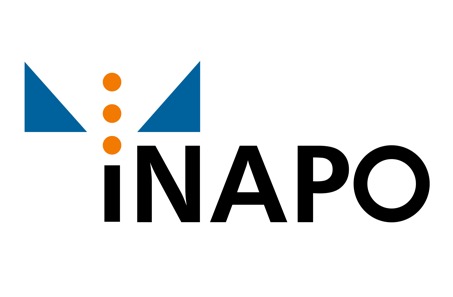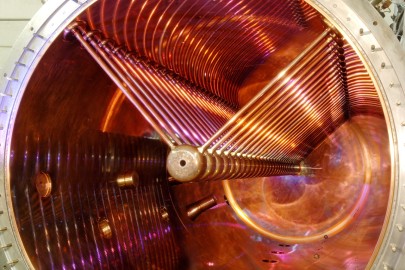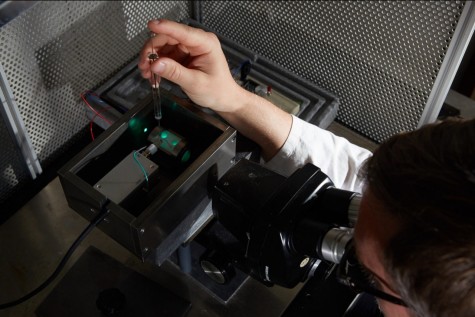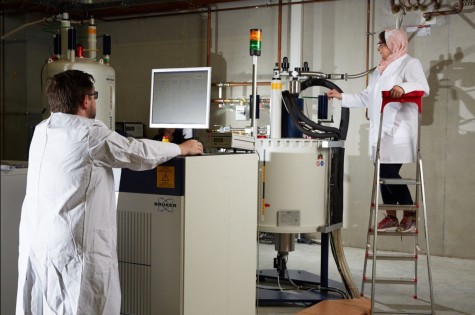PA 1 Engineering of Solid-State Pores
Project area 1 develops methods to introduce nanopores in polymer films with a combination of ion track technology and chemical etching. These synthetic nanopores are subjected to different organic chemical modifications to gain sensory properties. In particular they can serve as a platform for biological nanopores with high sensitivity and selectivity. These membranes are to be integrated by Micro-Nano-Integration (MNI) technology in a lab-on-chip device.
Preparation, characterization and modification of solid-state pores through heavy ion technology
Principal Investigator Christina Trautmann
Part of the project is based on the fabrication and modification of nanopores in polymer films. Christina Trautmann’s group (GSI / Material Science) has several years of experience in producing nanostructures with ion-track-nanotechnology. The synthetic nanopores are produced by ions of heavy elements which are shot through a polymer film. The rectilinear ion-track causes radiation damage, which is removed by a chemical etching process to obtain nanopores.
This requires the UNILAC high energy ion accelerator for heavy ions at GSI. In the polymer-based nanopore research this unique feature gives us the best possible working conditions and thus, also, a world leader position in this field.
Modified pores in polymer films for sensors and as platform for biological pores
Principal Investigator Wolfgang Ensinger
The group is working in the field of synthetic polymer-based nanopores. They use foils of standard polymers such as polycarbonate (PC) and polyethylenterephthalate (PET), which are widely used in large-scale, e. g. in beverage bottles, and are therefore easily available. The nanopores are produced by ion irradiation and chemical etching in cooperation with the group of Christina Trautmann. Both cylindrical and conical nanopores can be produced in polymer foils.
The nanopores surfaces contain chemically reactive groups which can be modified by coupling chemistry with functional groups, or with a functional polymer layer.
Surface functionalization of polymer membranes with switchable polymer films for the modulation of ion transport
Principal Investigator Markus Biesalksi
Markus Biesalksi’s group (Chemistry) has profound experience with the deposition and impregnation of functional polymers with stimuli-controlled functionality. This can be coupled with the polymer nanopores of the groups Trautmann and Ensinger. The thin polymeric films which are provided with nanoscale pores are modified with the aid of surface-bound polymer films.
The latter is intended to allow the transport through the pores via customized properties of the pore walls. In long term, the use of “switchable” polymer films allows a modulated transport through nanopores (eg. by temperature, pH, electrolyte content of the solution or light).
pH in confinement
Principal Investigator Annette Andrieu-Brunsen
Annette Andrieu-Brunsen’s research group is dedicated to the functionalization of spatially confined pores with responsive polymers to control molecular transport. In this context “pH” is an important parameter to control the charge within spatial confinement and thus to control pore accessibility. Thereby, spatial confinement influences “pH” in pores.
Here, we are interested in understanding the effect of spatial confinement on pore charge and “pH” in confined space by using pH-sensing dyes, fluorescence spectroscopy and in collaboration single molecule fluorescence.
Redox-responsive nanopores
Principal Investigator Markus Gallei
Scope and aim of Markus Gallei’s group is the incorporation of redox-responsive and switchable oligomers and polymers based on metal-organic compounds into nanopores. These so-called stimuli-responsive moieties will be addressed by soft oxidation and reduction reagents or by applying an electrical current in order to change their conformation and polarity. Thus, the properties of the functionalized nanopores can be reversibly switched.
PA 2 Engineering of Biological Pores
In project area 2 proteins are modified by genetic and protein engineering so that they have new sensor and switching characteristics. Cooperation between project areas 1 and 2 should lead to a stable integration of biological pores into the solid-state pores and /or that protein components for switching or sensing can be used in solid-state pores.
Small ion channels with new switching properties as selective pores in solid-state polymer films
Principal Investigator Gerhard Thiel
Gerhard Thiel’s group is working on very small and extremely robust biological pores (ion channels) that offer themselves as ideal building blocks for nanosensors. Their suitability is based on high heat resistance, high ion conductivity, susceptibility to genetic manipulation and the very simple structure. These robust channel proteins are to be integrated into miniaturized membrane bilayers that are stretched over nanopores in polymers and tested for stability. Using protein engineering, these channel proteins can be equipped with new switching and sensor properties.
In the long term switchable elements can be created which can be used in technical micro-devices for the analysis of medically relevant molecules.
Coupling of modified binding proteins in biological and artificial nanopores
Principal Investigator Bodo Laube
Bodo Laube’s group (Biology) investigates the ability of binding proteins (BP) to recognize individual analyte molecules specifically (extreme selectivity) and their enhancing effects (high sensitivity). Binding proteins represent a large protein superfamily of bacterial receptors that determine the selective binding of ligands such as carbohydrates, amino acids, peptides, anions, heavy metal cations etc. and they fulfill all requirements for a biosensor. The remarkable evolutionary adaptability and functional linkage of this superfamily in a variety of biological receptors is probably due to the positioning of the binding site at the interface between two domains and the resulting ligand-mediated conformational change.
This allows the functional linkage of binding proteins to other protein domains by confirmative coupling. This structure-function principle of binding proteins can be found in eukaryotic proteins as a selective sensor for complex molecules and in information processing neural systems. The diversity of ligand binding properties and the functional adaptability of the BP superfamily are used to generate new biosensors with new features in the medical /pharmaceutical field and in environmental analysis.
In silico design and optimization of composite ion channels
Principal Investigator Kay Hamacher
Kay Hamacher’s group (Biology) operates in the large-scale analysis of structure-function relationship of proteins and their complexes. Therefore, coarse-graining models, especially elastic network models, are performed for systematic investigations of dynamic-functional effects of mutations on ion channels. The small viral ion channels, which are analyzed in Gerhard Thiel’s group, are very well suited as a starting point for directed, engineering-oriented design of new features and switching characteristics in ion channels.
However, by merging domains which have had no interaction before, can lead to undesirable effects and reduce or even prevent the function. The elucidation of the mechanistic processes is an important step for deriving rational rules for the targeted design of new elements.
Chemical synthesis of switchable protein-based nanopore
Principal Investigator Alesia Tietze
The aim of Alesia Tietze’s group is the chemical synthesis of switchable (pH, ion-type, ligand binding) protein-based nanopores mimicking biological ion channels and peptides forming helix structures. The Fmoc-based solid-phase peptide synthesis (SPPS) of pore-forming membrane proteins (28 – 90 AA) will be accomplished applying novel methods developed in the group.
Chemical modifications of polymer facing residues anchoring to polymer-based scaffold will be integrated into the peptide/protein structure by variation of side-chain length and variety of chemical modifications.
Protein engineering of ion conducting nanopores
Principal Investigator Viktor Stein
The goal of the AG Stein is to re-engineer naturally occurring protein-based ion channels into highly specific biosensors that can detect biotechnologically and biomedically relevant molecules. Protein-based ion channels with custom response functions are constructed using a combination of structure-guided protein engineering and high-throughput screening. This is followed up by their detailed biophysical characterization to understand the molecular basis of their sensor function.
PA3 Transport through Porous Materials
Project area 3 uses high resolution NMR methods and theoretical approaches to analyze fundamental physico-chemical principles for ion transport in porous materials and the interaction of ions with material interfaces. The results from project area 3 will be used to design pores in the project areas 1 and 2.
Solid-state NMR of water and sodium in pores
Principal Investigator Gerd Buntkowsky
Information for the construction of pores is obtained from experimental data on ion transport in porous systems at the atomic level. Gerd Buntkowsky’s group (Chemistry) studies the behavior of small fluid sample molecules in confinement of complex mesoporous systems using solid-state NMR spectroscopy.
Their work shows that the characterization of fluid properties using solid-state NMR is possible and the technique is used to analyze the dynamic behavior of water and sodium ions in pores. A combination of solid-state NMR and DNP hyperpolarization technique is intended to detect the interior the ion channel pores of project area 2.
Particle transport in surface-modified solid-state pores
Principal Investigator Michael Vogel
The particle transport in nanopores in nature as well as in technology is of enormous importance. In general, the mobility of a particle (molecule or ion) in confinement differs substantially from the mobility in bulk. The interactions of the particle with the pore walls are responsible for this difference, they cause a sharp slowdown in particle dynamics.
Because of this, guest-host interaction exists in confinement usually a spatial dependence of the particle mobility, with reduced mobility near the pore walls and a bulk-like behavior in the pore center. Michael Vogel’s group (Physics) investigates the influence of the pore diameter, pore shape (cylindrical /conical) and the pore surface on the mobility of ions and water in confinement. These findings provide an important basis for the preparation of biomimetic solid-state pores. Various NMR methods are used for this project.
Molecular simulation of ion transport in functionalized nanopores
Principal Investigator Nico van der Vegt
Information and inspiration for the design of pores arise furthermore from theoretical approaches. Nico van der Vegt’s group (Chemistry) deals with the statistical thermodynamics and molecular simulation of solvatation-processes and ion-specific effects in soft matter in order to understand the interactions between ions, proteins and synthetic macromolecules in aqueous solution.
Combined with methodological developments in the area of multiscale-modeling of soft matter the opportunity arises to theoretically predict ion-selective, switchable pores based on functionalized pore-surfaces.
PA4 Micro-Nano Integration
In project area 4 already existing pore systems and new systems, that are developed in the other project areas, are coupled to microelectronic systems to register electrical signals on a miniature scale.
Integration of nanopores in lab-on-chip systems
Principal Investigator Helmut F. Schlaak
Helmut F. Schlaak’s group (Electrical Engineering) has several years of experience in the field of micro-nano-integration. In particular, the on-site production of metallic wires with a diameter of less than 1 micron represents a priority. As an intermediate step a chemically etched ion-track polymer foil has to be integrated into a micro-system already. Therefore, the necessary process steps and handling procedures are known and can be used in the iNAPO project to build a lab-on-chip system.































